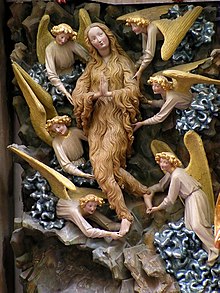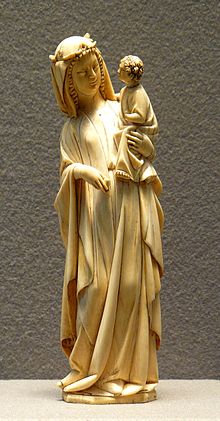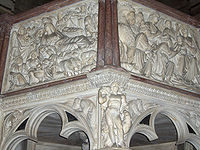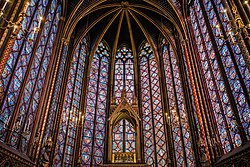Gothic Wall Art Two Women Day of the Dead
| Summit: The Western (Imperial) Portal of the Chartres Cathedral (circa 1145), these architectural statues being the primeval Gothic sculptures and a revolution in style and the model for a generation of sculptors; Centre: The Sainte-Chapelle from Paris (1194-1248); Lesser: The Wilton Diptych (1395–1459) | |
| Years agile | Late 12th century-16th century |
|---|---|
Gothic art was a manner of medieval fine art that adult in Northern French republic out of Romanesque art in the 12th century AD, led past the concurrent development of Gothic architecture. It spread to all of Western Europe, and much of Northern, Southern and Primal Europe, never quite effacing more than classical styles in Italian republic. In the late 14th century, the sophisticated court mode of International Gothic developed, which continued to evolve until the belatedly 15th century. In many areas, particularly Germany, Late Gothic art connected well into the 16th century, before being subsumed into Renaissance fine art. Chief media in the Gothic period included sculpture, panel painting, stained drinking glass, fresco and illuminated manuscripts. The hands recognizable shifts in architecture from Romanesque to Gothic, and Gothic to Renaissance styles, are typically used to ascertain the periods in fine art in all media, although in many ways figurative fine art developed at a different step.
The earliest Gothic fine art was monumental sculpture, on the walls of Cathedrals and abbeys. Christian fine art was frequently typological in nature (see Medieval allegory), showing the stories of the New Attestation and the Onetime Testament adjacent. Saints' lives were ofttimes depicted. Images of the Virgin Mary changed from the Byzantine iconic course to a more human and affectionate mother, cuddling her baby, swaying from her hip, and showing the refined manners of a well-born aristocratic courtly lady.
Secular art came into its own during this period with the rise of cities, foundation of universities, increase in trade, the establishment of a money-based economy and the creation of a bourgeois grade who could beget to patronize the arts and commission works, resulting in a proliferation of paintings and illuminated manuscripts. Increased literacy and a growing body of secular vernacular literature encouraged the representation of secular themes in fine art. With the growth of cities, trade guilds were formed and artists were often required to exist members of a painters' guild. As a consequence, considering of better tape keeping, more artists are known to us by name in this period than any previous; some artists were yet assuming as to sign their names.
Origins [edit]

Gothic art emerged in Île-de-France, French republic, in the early 12th century at the Abbey Church of St Denis built by Abbot Suger.[one] The style rapidly spread beyond its origins in architecture to sculpture, both monumental and personal in size, fabric art, and painting, which took a variety of forms, including fresco, stained drinking glass, the illuminated manuscript, and panel painting.[2] Monastic orders, especially the Cistercians and the Carthusians, were important builders who disseminated the style and adult distinctive variants of it across Europe. Regional variations of compages remained important, even when, by the belatedly 14th century, a coherent universal style known as International Gothic had evolved, which connected until the late 15th century, and beyond in many areas.
Although in that location was far more secular Gothic art than is often thought today, equally generally the survival rate of religious art has been improve than for secular equivalents, a large proportion of the art produced in the menstruation was religious, whether commissioned by the church building or by the laity. Gothic fine art was ofttimes typological in nature, reflecting a belief that the events of the Old Testament pre-figured those of the New, and that this was indeed their main significance. Onetime and New Testament scenes were shown side by side in works like the Speculum Humanae Salvationis, and the decoration of churches. The Gothic catamenia coincided with a corking resurgence in Marian devotion, in which the visual arts played a major role. Images of the Virgin Mary developed from the Byzantine hieratic types, through the Coronation of the Virgin, to more human and intimate types, and cycles of the Life of the Virgin were very pop. Artists like Giotto, Fra Angelico and Pietro Lorenzetti in Italy, and Early Netherlandish painting, brought realism and a more than natural humanity to fine art. Western artists, and their patrons, became much more confident in innovative iconography, and much more originality is seen, although copied formulae were still used by about artists.
Iconography was affected by changes in theology, with depictions of the Assumption of Mary gaining ground on the older Death of the Virgin, and in devotional practices such as the Devotio Moderna, which produced new treatments of Christ in subjects such equally the Man of Sorrows, Pensive Christ and Pietà, which emphasized his human suffering and vulnerability, in a parallel motion to that in depictions of the Virgin. Even in Last Judgements Christ was at present usually shown exposing his chest to testify the wounds of his Passion. Saints were shown more frequently and altarpieces showed saints relevant to the particular church or donor in omnipresence on a Crucifixion or enthroned Virgin and Child, or occupying the central space themselves (this usually for works designed for side-chapels). Over the menses many ancient iconographical features that originated in New Attestation apocrypha were gradually eliminated under clerical force per unit area, similar the midwives at the Nativity, though others were as well well-established, and considered harmless.[3]
Etymology [edit]

The word "Gothic" for art was initially used as a synonym for "Barbaric", and was therefore used pejoratively.[4] Its critics saw this type of Medieval art every bit unrefined and too remote from the aesthetic proportions and shapes of Classical art.[v] Renaissance authors believed that the Sack of Rome past the Gothic tribes in 410 had triggered the demise of the Classical world and all the values they held love. In the 15th century, various Italian architects and writers complained that the new "barbaric" styles filtering downwardly from north of the Alps posed a similar threat to the classical revival promoted by the early on Renaissance.[half dozen] The "Gothic" qualifier for this fine art was first used in Raphael's letter to Pope Leo X c. 1518 and was subsequently popularised by the Italian artist and writer Giorgio Vasari,[vii] who used it as early as 1530, calling Gothic art a "monstrous and vicious" "disorder".[eight] Raphael claimed that the pointed arches of northern compages were an echo of the archaic huts the Germanic forest dwellers formed past bending copse together – a myth which would resurface much afterwards in a more than positive sense in the writings of the German Romantic movement. "Gothic art" was strongly criticized by French authors such as Boileau, La Bruyère, Rousseau, before condign a recognized form of art, and the wording becoming stock-still.[five] Molière would famously annotate on Gothic:
The besotted taste of Gothic monuments,
These odious monsters of ignorant centuries,
Which the torrents of barbary spewed forth.[v]
In its beginning, Gothic art was initially chosen "French work" (Opus Francigenum), thus attesting the priority of French republic in the cosmos of this style.[v]
Painting [edit]

Painting in a style that tin can be called Gothic did not appear until virtually 1200, about 50 years later the origins of Gothic compages and sculpture. The transition from Romanesque to Gothic is very imprecise and not at all a clear break, and Gothic ornamental detailing is often introduced before much change is seen in the style of figures or compositions themselves. And then figures get more than animated in pose and facial expression, tend to be smaller in relation to the groundwork of scenes, and are arranged more freely in the pictorial space, where there is room. This transition occurs first in England and French republic around 1200, in Deutschland around 1220 and Italian republic around 1300. Painting during the Gothic menstruum was skillful in four primary media: frescos, console paintings, manuscript illumination and stained glass.
Frescoes [edit]
Frescoes continued to exist used every bit the master pictorial narrative craft on church walls in southern Europe as a continuation of early Christian and Romanesque traditions. An blow of survival has given Kingdom of denmark and Sweden the largest groups of surviving church building wall paintings in the Biblia pauperum fashion, usually extending up to recently constructed cross vaults. In both Denmark and Sweden, they were almost all covered with limewash after the Reformation which has preserved them, simply some have also remained untouched since their creation. Among the finest examples from Denmark are those of the Elmelunde Master from the Danish isle of Møn who decorated the churches of Fanefjord, Keldby and Elmelunde.[9] Albertus Pictor is arguably the most well-known fresco artist from the period working in Sweden. Examples of Swedish churches with well-preserved frescos include Tensta, Gökhem and Anga churches.
Stained glass [edit]

Office of German stained glass panel of 1444 with the Visitation; pot metal of diverse colours, including white glass, black vitreous paint, xanthous argent stain, and the "olive-green" parts are enamel. The plant patterns in the red heaven are formed by scratching abroad black paint from the crimson glass before firing. A restored console with new lead cames.
In northern Europe, stained glass was an important and prestigious form of painting until the 15th century, when it became supplanted by panel painting. Gothic architecture greatly increased the amount of glass in large buildings, partly to allow for wide expanses of drinking glass, as in rose windows. In the early on part of the period mainly blackness pigment and clear or brightly coloured glass was used, but in the early 14th century the use of compounds of silverish, painted on glass which was and so fired, immune a number of variations of colour, centred on yellows, to be used with clear glass in a single slice. By the end of the flow designs increasingly used large pieces of drinking glass which were painted, with yellows as the ascendant colours, and relatively few smaller pieces of drinking glass in other colours.[10]
Manuscripts and printmaking [edit]

Illuminated manuscripts represent the virtually complete tape of Gothic painting, providing a record of styles in places where no monumental works have otherwise survived. The primeval full manuscripts with French Gothic illustrations date to the middle of the 13th century.[11] Many such illuminated manuscripts were royal bibles, although psalters likewise included illustrations; the Parisian Psalter of Saint Louis, dating from 1253 to 1270, features 78 full-page illuminations in tempera paint and gilt leaf.[12]
During the late 13th century, scribes began to create prayer books for the laity, often known as books of hours due to their utilize at prescribed times of the twenty-four hour period.[12] Amidst the primeval is an example past William de Brailes that seems to have been written for an unknown laywoman living in a small-scale hamlet virtually Oxford in about 1240. Nobility frequently purchased such texts, paying handsomely for decorative illustrations; amongst the nearly well-known creators of these is Jean Pucelle, whose Hours of Jeanne d'Evreux was deputed by King Charles IV as a gift for his queen, Jeanne d'Évreux.[13] Elements of the French Gothic present in such works include the utilize of decorative folio framing reminiscent of the architecture of the time with elongated and detailed figures.[12] The utilize of spatial indicators such as building elements and natural features such as copse and clouds also denote the French Gothic style of illumination.[12]
From the eye of the 14th century, blockbooks with both text and images cut every bit woodcut seem to accept been affordable by parish priests in the Low Countries, where they were most pop. By the cease of the century, printed books with illustrations, still by and large on religious subjects, were apace becoming accessible to the prosperous middle class, as were engravings of adequately high quality by printmakers similar Israhel van Meckenem and Chief Due east. S. In the 15th century, the introduction of inexpensive prints, generally in woodcut, fabricated it possible even for peasants to take devotional images at home. These images, tiny at the bottom of the market, frequently crudely coloured, were sold in thousands but are now extremely rare, almost having been pasted to walls.
Altarpiece and console painting [edit]
Painting with oil on sail did not get popular until the 15th and 16th centuries and was a authentication of Renaissance art. In Northern Europe the of import and innovative school of Early Netherlandish painting is in an essentially Gothic fashion, only tin can also be regarded as part of the Northern Renaissance, equally in that location was a long delay before the Italian revival of involvement in classicism had a great impact in the north. Painters similar Robert Campin and Jan van Eyck made utilise of the technique of oil painting to create minutely detailed works, correct in perspective, where apparent realism was combined with richly complex symbolism arising precisely from the realistic item they could at present include, even in small works. In Early Netherlandish painting, from the richest cities of Northern Europe, a new minute realism in oil painting was combined with subtle and complex theological allusions, expressed precisely through the highly detailed settings of religious scenes. The Mérode Altarpiece (1420s) of Robert Campin and the Washington Van Eyck Proclamation or Madonna of Chancellor Rolin (both 1430s, by Jan van Eyck) are examples.[14] For the wealthy, small panel paintings, even polyptychs in oil painting were becoming increasingly popular, frequently showing donor portraits aslope, though often much smaller than the Virgin or saints depicted. These were usually displayed in the habitation.
Sculpture [edit]
Awe-inspiring sculpture [edit]

French ivory Virgin and Kid, end of the 13th century, 25 cm high, curving to fit the shape of the ivory tusk.
The Gothic period is substantially defined by Gothic architecture, and does non entirely fit with the evolution of style in sculpture in either its start or cease. The facades of large churches, especially around doors, continued to have large tympanums, but also rows of sculpted figures spreading around them.
The statues on the Western (Royal) Portal at Chartres Cathedral (c. 1145) show an elegant merely exaggerated columnar elongation, but those on the south transept portal, from 1215–20, prove a more naturalistic style and increasing detachment from the wall backside, and some awareness of the classical tradition. These trends were continued in the w portal at Reims Cathedral of a few years later on, where the figures are virtually in the round, equally became usual as Gothic spread across Europe.[15] Bamberg Cathedral has perhaps the largest assemblage of 13th century sculpture, culminating in 1240 with the Bamberg Passenger, the first life-size equestrian statue in Western fine art since the 6th century.
In Italia Nicola Pisano (1258–78) and his son Giovanni developed a manner that is often chosen Proto-Renaissance, with unmistakable influence from Roman sarcophagi and sophisticated and crowded compositions, including a sympathetic treatment of nudity, in relief panels on their pulpit of Siena Cathedral (1265–68), the Fontana Maggiore in Perugia, and Giovanni's pulpit in Pistoia of 1301.[sixteen]
Another revival of classical style is seen in the International Gothic piece of work of Claus Sluter and his followers in Burgundy and Flemish region around 1400.[17] Late Gothic sculpture connected in the North, with a fashion for very large, wooden, sculpted altarpieces with increasingly virtuoso carving and large numbers agitated expressive figures; virtually surviving examples are in Germany, after much iconoclasm elsewhere. Tilman Riemenschneider, Veit Stoss and others continued the style well into the 16th century, gradually absorbing Italian Renaissance influences.[18]
Life-size tomb effigies in rock or alabaster became pop for the wealthy, and thousand multi-level tombs evolved, with the Scaliger Tombs of Verona so large they had to be moved outside the church. By the 15th century at that place was an manufacture exporting Nottingham alabaster chantry reliefs in groups of panels over much of Europe for economical parishes who could non afford stone retables.[19]
-

-

-

-

Base of the Holy Thorn Reliquary, French (Paris), 1390s, a Resurrection of the Expressionless in gilded, enamel and gems.
-

-

-
Portable sculpture [edit]

Small carvings, for a mainly lay and ofttimes female market, became a considerable industry in Paris and some other centres. Types of ivories included small-scale, devotional polyptychs, single figures, especially of the Virgin, mirror-cases, combs, and elaborate caskets with scenes from Romances, used every bit appointment presents.[20] The very wealthy collected extravagantly elaborate, jewelled and enamelled metalwork, both secular and religious, like the Duc de Berry's Holy Thorn Reliquary, until they ran short of money, when they were melted downward again for cash.[21]

Ivory diptych, with some of the coloured paint remaining. Adoration of the Magi and Crucifixion. Meuse valley, French republic, c. 1350.
Gothic sculptures contained of architectural ornament were primarily created as devotional objects for the home or intended as donations for local churches,[22] although pocket-sized reliefs in ivory, bone and woods embrace both religious and secular subjects, and were for church and domestic utilise. Such sculptures were the work of urban artisans, and the most typical subject for three dimensional small statues is the Virgin Mary alone or with child.[23] Paris was the main middle of ivory workshops, and exported to most of northern Europe, though Italy also had a considerable production. An exemplar of these contained sculptures is among the collections of the Abbey Church of St Denis; the silver-gilt Virgin and Child dates to 1339 and features Mary enveloped in a flowing cloak holding an infantile Christ effigy.[23] Both the simplicity of the cloak and the youth of the child presage other sculptures found in northern Europe dating to the 14th century and early 15th century.[23] Such sculpture shows an evolution from an before strong and elongated style, all the same partly Romanesque, into a spatial and naturalistic feel in the belatedly twelfth and early 13th century.[23] Other French Gothic sculptural subjects included figures and scenes from popular literature of the time.[23] Imagery from the poetry of the troubadours was particularly popular amongst artisans of mirror-cases and small boxes presumably for employ by women.[23] The Casket with Scenes of Romances (Walters 71264) of 1330–fifty is an unusually large example with space for a number of scenes from different literary sources.
Souvenirs of pilgrimages to shrines, such as dirt or lead badges, medals and ampullae stamped with images were also popular and cheap. Their secular equivalent, the livery badge, showed signs of feudal and political loyalty or brotherhood that came to be regarded as a social menace in England nether bastard feudalism. The cheaper forms were sometimes given away gratuitous, every bit with the xiii,000 badges ordered in 1483 past King Richard Three of England in fustian cloth with his keepsake of a white boar for the investiture of his son Edward every bit Prince of Wales,[24] a huge number given the population at the time. The Dunstable Swan Precious stone, modelled fully in the round in enamelled gold, is a far more than exclusive version, that would accept been given to someone very close or important to the donor.
Run across also [edit]
| | Wikimedia Commons has media related to Gothic art. |
- Blackletter (besides known as Gothic script)
- Church frescos in Denmark
- Church building frescos in Sweden
- Danse Macabre
- Gothic cathedrals and churches
- History of painting
- List of Gothic artists
- Pleurants
- Renaissance of the 12th century
- The Ten Virgins
- Timeline of Italian artists to 1800
- Western painting
Notes [edit]
- ^ Stokstad (2005), 516.
- ^ Stokstad (2005), 544.
- ^ Émile Mâle, The Gothic Image, Religious Art in French republic of the Thirteenth Century, pp. 165–8, English language trans of 3rd edn, 1913, Collins, London (and many other editions) is a classic work on French Gothic church fine art
- ^ "Gothic art". Encyclopedia Britannica . Retrieved 22 June 2017.
- ^ a b c d History of Compages Super Review. Inquiry & Didactics Assoc. ISBN978-0-7386-6996-0.
- ^ E. Due south. de Beer, Gothic: Origin and Diffusion of the Term; The Idea of Way in Architecture in Journal of the Warburg and Courtauld Institutes, Vol.eleven, 1948, pp. 143–62
- ^ Vasari, Giorgio (1 Jan 1960). Vasari on Technique. Being the Introduction to the 3 Arts of Design, Architecture, Sculpture and Painting, Prefixed to the Lives of the Most Splendid Painters, Sculptors and Architects. Dover Publications. ISBN978-0-486-20717-ix.
- ^ The art of the sublime: principles of Christian art and architecture by Roger Homan p. lxx [i]
- ^ Kirsten Trampedach: Introduction to Danish Wall Paintings – Conservation Ethics and Methods of Treatment. National Museum of Denmark Archived 24 November 2009 at the Wayback Machine. Retrieved 6 September 2009.
- ^ Coe, 8–xi
- ^ Stokstad (2005), 540.
- ^ a b c d Stokstad (2005), 541.
- ^ Stokstad (2005), 542.
- ^ Lane, Barbara G,The Altar and the Altarpiece, Sacramental Themes in Early Netherlandish Painting, Harper & Row, 1984, ISBN 0-06-430133-8 analyses all these works in particular. See also the references in the manufactures on the works.
- ^ Honour and Fleming, 297–300; Henderson, 55, 82–84
- ^ Olson, xi–24; Award and Fleming, 304; Henderson, 41
- ^ Snyder, 65–69
- ^ Snyder, 305–311
- ^ 5&A Museum feature on the Nottingham alabaster Swansea Altarpiece
- ^ Calkins, 193–198
- ^ Cherry, 25–48; Henderson, 134–141
- ^ Stokstad (2005), 537.
- ^ a b c d eastward f Stokstad (2005), 539.
- ^ Crimson (2003), 204
References [edit]
- Calkins, Robert Chiliad.; Monuments of Medieval Art, Dutton, 1979, ISBN 0525475613
- Cherry, John. The Holy Thorn Reliquary, 2010, British Museum Printing (British Museum objects in focus), ISBN 0-7141-2820-1
- Scarlet, John, in Marks, Richard and Williamson, Paul, eds. Gothic: Art for England 1400–1547, 2003, V&A Publications, London, ISBN ane-85177-401-7
- Henderson, George. Gothic, 1967, Penguin, ISBN 0-14-020806-2
- Hugh Laurels and John Fleming, A Earth History of Art, 1st edn. 1982 (many afterward editions), Macmillan, London, folio refs to 1984 Macmillan 1st edn. paperback. ISBN 0333371852
- Olson, Roberta J.One thousand., Italian Renaissance Sculpture, 1992, Thames & Hudson (World of Art), ISBN 978-0-500-20253-1
- Robinson, James, Masterpieces of Medieval Art, 2008, British Museum Press, ISBN 978-0-7141-2815-three
- Rudolph, Conrad, ed., A Companion to Medieval Fine art: Romanesque and Gothic in Northern Europe, 2006, ISBN 978-1405198783
- Rudolph, Conrad, "Inventing the Gothic Portal: Suger, Hugh of Saint Victor, and the Construction of a New Public Art at Saint-Denis," Art History 33 (2010) 568–595
- Rudolph, Conrad, "Inventing the Exegetical Stained-Glass Window: Suger, Hugh, and a New Elite Art," Fine art Bulletin 93 (2011) 399–422
- Snyder, James. Northern Renaissance Art, 1985, Harry N. Abrams, ISBN 0136235964
External links [edit]
- Gothic Art and Architecture
- Gothic art, from ArtCyclopedia.com
- Gothic art, from Encyclopædia Britannica Online.
- Gothic fine art (Archived 2009-10-31), from Microsoft Encarta.
- Gothic fine art Archived 5 March 2005 at the Wayback Machine, from The Columbia Encyclopedia, Sixth Edition. 2001.
- Gothic art, Museumsportal Schleswig-Holstein
- Gothic art, from "A World History of Art" and [2].
- "Gothic: Art for England 1400–1547". Victoria and Albert Museum. Retrieved eight June 2007.
- The Pietà in French late Gothic sculpture: regional variations, a volume from The Metropolitan Museum of Art Libraries (fully available online as PDF), which contains material on Gothic art
Source: https://en.wikipedia.org/wiki/Gothic_art




0 Response to "Gothic Wall Art Two Women Day of the Dead"
Post a Comment